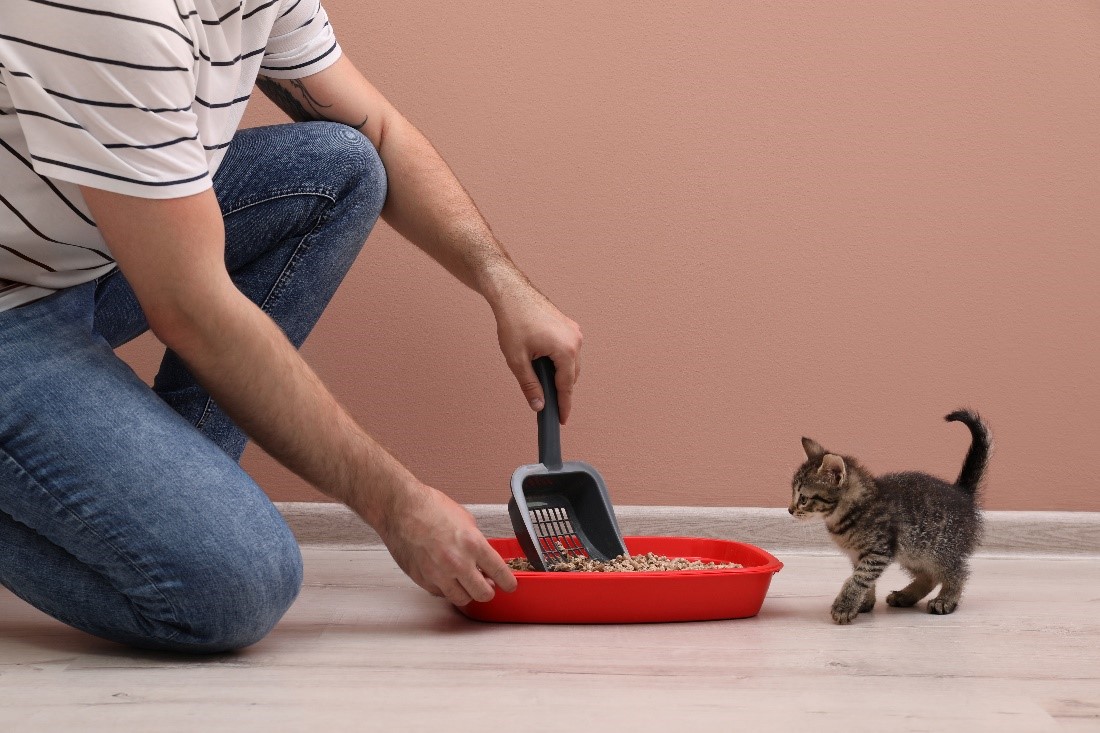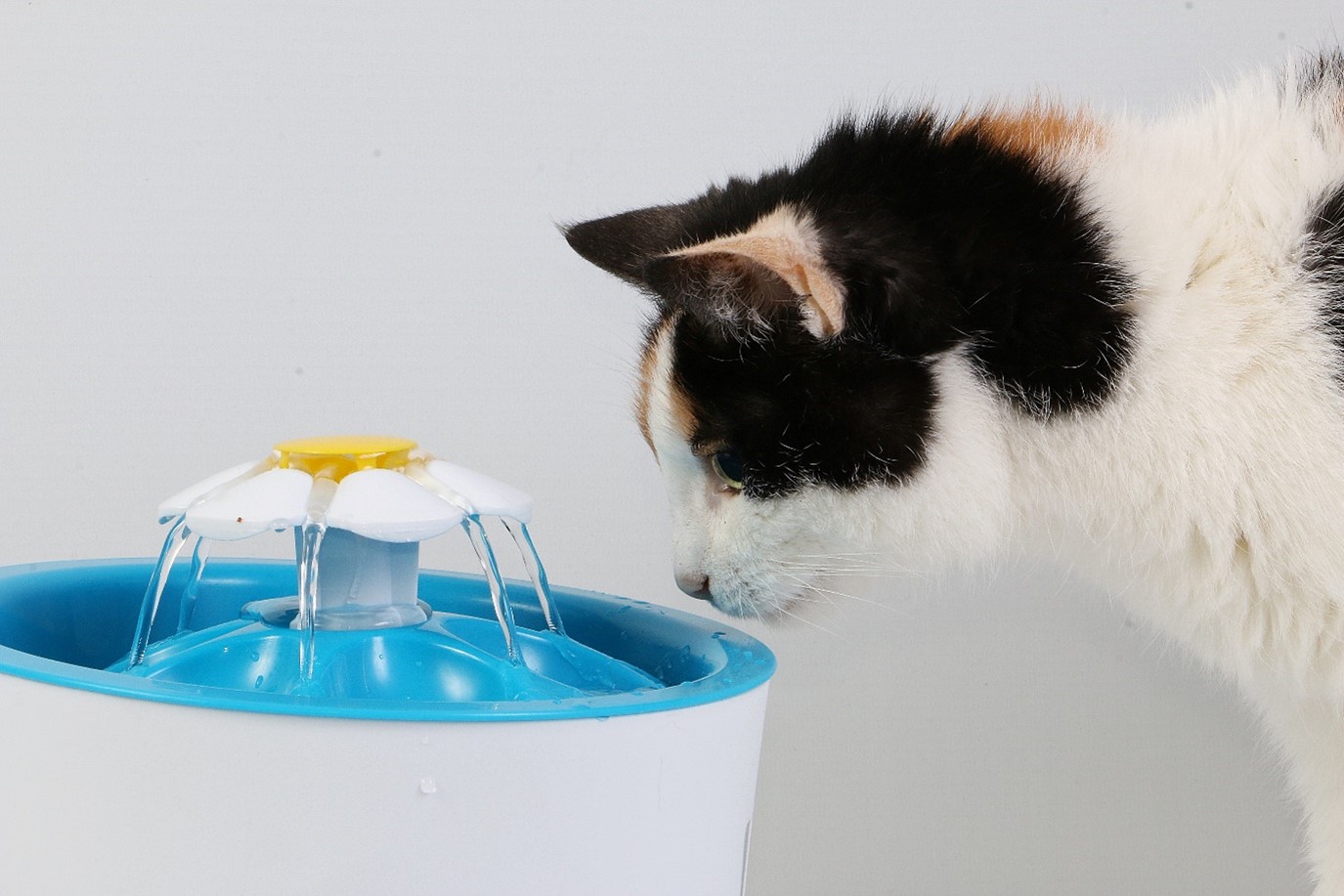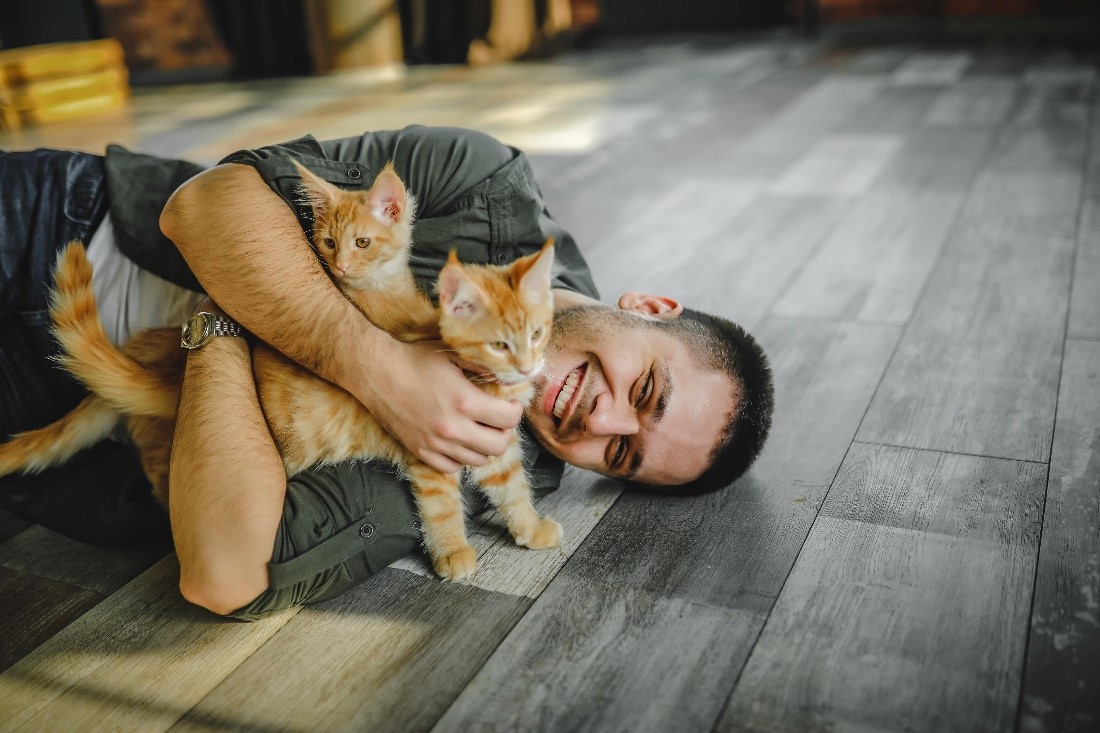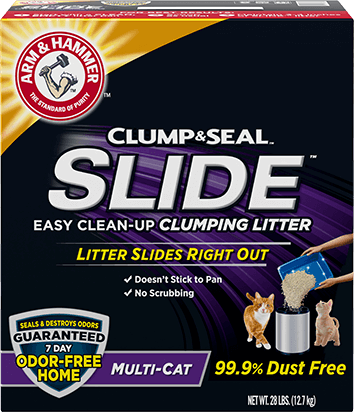1. Cat carrier
In order to bring your new cat or kitten home safely, you need a cat carrier. If you’re adopting a kitten, the shelter may have cardboard carriers or one you can borrow and return. But to take kitty to their vet visits and if you’re ever going to travel with your cat, a carrier is a must.
You can choose from a backpack style cat carrier, a soft-sided carrier with a shoulder strap, or a hard-sided carrier with a swing door. Look for a cat carrier that allows you to drop your cat in from the top vs one of the ends.
2. A litter box for each cat (and a place to put it)
When your new kitten or cat arrives home, you’ll need to show them where they should do their business.
Litter boxes come in various sizes and styles. Which litter box you choose will depend on whether you have a small apartment or a large home, where you’re putting it, and your cat’s needs. Remember: you need one litter box for each cat in your household, and ideally an extra one. You can have different types of litter boxes as available options.
Some litter box styles to choose from include:
- High-sided, open top: good for cats who don’t like enclosed spaces and helping keep litter in the box.
- Front entry, rimmed: even higher sides for litter control and privacy, but with an open top that some cats prefer.
- Front entry, covered or hooded: good for hiding the litter box, helping control odor, and for cats that like privacy.
- Open top, sifting trays: good for cats that like an open box and for cat parents who like the convenience of lifting the top tray and scooping all feces and clumped urine at once.
- Top entry: this style litter box tends to be the best at controlling litter tracking, and is good for cats who like privacy when toileting.
- Automatic or self-cleaning: these electronic litter boxes are self-scooping, creating a fresh litter box after each time your cat goes.
If you’re bringing home a kitten, a small litter box might be a good idea now as they learn and grow. But, you’ll need to buy a new, cat-sized box as they get bigger if you go this route. Ideally, you’ll have the litter box set up when you arrive home with your new furbaby, but if not, you can leave them in their cat carrier while you get it ready. Check out our tips for how to set up a litter box properly and how to litter train a kitten for guidance.
3. A cat litter you and your cat agree on

Cat litter. It’s now on your list of essential supplies and a new monthly expense in your family budget, just like toilet paper or diapers. Review our guidelines for what cat litter is made of to help you decide if scented vs. unscented litter, lightweight litter vs. regular, or another type of cat litter is best for you.
Hint: the best litter is one that your cat will use regularly without problems and that you can live with in terms of odor control, tracking, carrying, and cleanup. Consider a premium cat litter for even tighter clumping and longer odor control, or a value cat litter to maximize cost and cleanup efficiency.
4. Litter box cleaning supplies
If you have a dog, you have to pick up poop from the ground. If you have a baby, you have to change diapers. And if you have a cat, you have to clean a litter box. Dealing with toileting and waste removal is part of life. Having the right supplies and routine will make this part of cat parenting easier.
- Litter box scoop: Get yourself a large, sturdy litter box scoop. You’ll be using this tool every time you remove clumps of pee or poop from the box, which might be every day, but at least once per week. Since a litter scoop is such a critical tool, invest in a good one. We like this litter scoop with an ergonomic handle and a place for waste removal bags for streamlined storage. Keep a package of refill waste removal bags on hand for when you run out.
- A cat litter mat : is more than a nice-to-have on your cat supplies checklist. Litter mats help catch litter particles from your cat’s paws as they exit the box, or trap any bits that kitty might exuberantly fling from an open litter pan. Reducing litter tracking around your home makes a litter mat well worth it. Cat litter mats come in rectangular, semicircle and oversized styles, so decide which one works best for your litter box and location.
Some other must-have cat litter box maintenance supplies include:
- Cat Litter Deodorizer: Even though your litter will help absorb urine and smells, use ARM & HAMMER™ Cat Litter Deodorizer to add extra freshness daily and help destroy feces and urine odor on contact. Available in a powder deodorizer you sprinkle on the litter or a spray deodorizer that dispenses a fine mist that won’t interfere with litter clumping.
- Odor Neutralizers: ARM & HAMMER™ Purifying Pak is a small slotted container filled with baking soda to hang on the side of your litter box or place near kitty’s toilet area. Or slip an ARM & HAMMER™ Puck pre-filled with lavender-scented baking soda by the litter pan to absorb and neutralize odors.
- Litter Waste Bags: Although you can use any bag to hold the waste you scoop from the litter box, we recommend ARM & HAMMER™ Fresh Scent Litter Bags for a fresh pick-up. Each bag is lined with baking soda to continue neutralizing odor and help keep your trash can from getting smelly.
- Litter Box Liners: Many cat parents like the convenience and easy clean-up that comes from lining the litter pan with a drawstring bag. These liners work with any kind of litter, but may be especially helpful if you use a natural or non-clumping litter that requires dumping and replacing all the litter when you clean the box.
- Litter Box Filter: Covered litter boxes often have a place for a litter box filter to help absorb odors.
- Pet Stain & Odor Remover:Pets come with the inevitable stains, odors, and hair to clean up. Be at the ready for any mishaps by adding a pet stain and odor remover to your cat essentials checklist. We like ARM & HAMMER™ Pet Stain and Odor Eliminator Plus OxiClean™ with the combined power of baking soda odor neutralizers and oxygen-powered stain fighters.
5. Appropriate cat or kitten food & treats
Your kitten or cat will need nutritious and delicious food to eat and treats for training and extra attention. When you adopt your cat, ask the shelter for some of the food they have been eating to take with you. Minimizing changes in diet when your new cat is already experiencing many other changes tends to help them adjust better. If you want to use a different kind of food, introduce it slowly by mixing with the former food over a few days to help reduce tummy upset.
Don’t buy a huge bag of food before you bring your cat home the first time. Every cat is different, and you’ll want to check with your veterinarian for what type of food they recommend for your cat or kitten. There are different food formulations depending on your cat’s needs, activity level, weight, age, and any food sensitivities. And, you’ll want to find the right food within your family’s budget as well. Check out some other ideas for what cats can eat (and what they should not eat).
Once you’ve gotten to know your cat a little better and learned about their preferences and digestion, you can settle on a specific daily food that will become their fond favorite.
6. Cat food and water dishes

Kitty will need designated food and water dishes when you bring them home. Go with a wider, shallower dish when possible because some kitties have sensitive whiskers that hurt when they try to push their face into narrower openings to eat or drink.
You might decide to provide food on a schedule a couple times per day. Alternatively, you can use a convenient gravity feeder (if your cat doesn’t over-eat) to have kibble available whenever kitty feels peckish. Gravity feeders are also good if you can’t get home for a scheduled feeding time, giving kitty access to food and you peace of mind.
Fresh, clean, cool water should be available at all times for your cat or kitten. Getting enough water is crucial for kitty’s overall health. You can use a small bowl for kitty’s water, or opt for a larger gravity waterer that doesn’t need to be filled as often and has anti-microbial protection built-in.
Cats can be particular when it comes to how they like their water served. Some instinctually prefer drinking from moving water since still water can be stagnant or unhealthy in the wild. If your new cat develops an affinity for drinking from the toilet or the faucet, consider getting a cat water fountain to provide the moving water many cats prefer.
7. Tools & supplies for grooming kitty
Cats mostly clean themselves, but you will have to help kitty regularly cut their nails and brush their teeth. Plus, most cats enjoy having their coat brushed, and using a deshedding cat brush helps you both bond with kitty and remove some excess hair.
If you’re bringing home a new kitten, get them used to weekly nail trimming and tooth brushing when they are little, and it’ll be easier as they grow. Plus, you’ll be setting them up for healthier claws and oral health all their lives!
Unless you have a hairless cat, you may never need to bathe your cat. But sometimes kitty paws need wiping down, and occasionally cats may need a wipe of their coat if they got especially dirty, your kitten decided to wrestle their sibling in the litter box, or your elder cat needs a little grooming help.
Keep a package of ARM & HAMMER™ Dander-Reducing Cat Wipes on hand to help soothe your kitty with a light lavender scent and help remove dander and odor from your cat’s coat.
8. Interactive cat toys
Playing with your new cat or kitten will help you bond with them, and cats need to have interactive toys to help them exercise their curious minds and agile bodies. Invest in some toys that kitty can play with on their own, such as balls or puzzle toys and some that you play with your cat, such as wand toys. Get more ideas in our top ways to have fun with your cat article.
9. Soft blankets or cat beds for curling up
Cats are champion nappers, and sleep for an average of 12 to 16 hours per day, usually in snatches of about an hour each. Cats and kittens tend to love soft fleece blankets or cat beds that they can make biscuits on and curl into loaves, cinnamon rolls, or croissants.
Since cats have polyphasic sleep patterns (a fancy term for sleeping multiple times per day instead of one long stretch), and they tend to move around from spot to spot as they catch zzz’s. Kitty might follow the sunshine as the day wears on, or switch from atop a bed to under it.
Make sure you have plenty of excellent spots in a variety of locations for kitty to curl up on. Young kittens and elder cats also appreciate a low-heat heating pad covered with a blanket to help them stay cozy and to mimic the warmth of siblings or other cats they may have cuddled up with before they came home with you.
Consider getting a special designated bed for your new cat or kitten, such as this oval foam lounger bed with high sides that help kitty feel surrounded and safe. You’ll appreciate the anti-microbial fabric and the ability to remove the cover to wash it, while kitty will love the soft, fluffy surface and cozy cushion that’s just right for catching a cat nap.
10. Scratching post or pads
Cats have an instinctual and biological need to sharpen their claws by scratching. It can help them mark their territory (there are scent glands in those beautiful toebeans), stretch, and shed the outer covering of their nails. It’s even part of expressing emotion for kitties. Do not declaw a cat, as this can cause them lifelong pain.
According to the ASPCA, most cats prefer a vertical scratching post that’s at least 32” high, covered in sisal, and doesn’t wobble when used. You can also try the cardboard scratchers that sit on the floor, which kitties also enjoy. Just don’t be surprised to see them sitting on top of them as well. Cats are legendary for sitting in squares.
Whichever type of cat scratcher you choose, make sure you have one on your cat essentials checklist to help protect your furniture and curtains from kitty’s claws.
11. Cat tree or perches for climbing
Most cats love to climb and to be up high. While you may not have a Pride Rock in your home for kitty to look out over their domain, you can create some excellent perches and places for kitty to exercise in your home. Try window-mounted perches so kitty can look out and watch wildlife TV while the birds and critters stay safe from your cat’s hunting instincts. You can also purchase or make DIY cat furniture that provides places for kitty to climb and nap from on high.
Another idea is to create a catio – a cat patio that can be as small as a window box or as large as a kitty screened porch – to help bring the outdoors in for kitty. Cats are amazing agile athletes who need to run and climb, so set them up for success with safe places to leap and land.
12. Catnip and/or Calming Spray

Catnip and/or calming sprays aren’t essential cat supplies when you’re bringing home a cat or kitten, but they are nice to have nonetheless. Classic cat calming sprays (or collars or treats) mimic feline pheromones to help cats feel less anxious and more calm. They can be helpful for diffusing the tension when introducing a new cat or to ease the transition of adoption.
Catnip also tends to help your cat feel less anxious and more mellow. It can help encourage playtime and help your cat feel more at ease with you. The way each cat reacts to either catnip or a pheromone spray is different, so consider adding these to your new cat checklist to have on hand if tensions rise and to see if they help your kitty.
13. Your love, attention, and patience
Here’s something you don’t have to buy online or in any retail store but is an essential cat supply. All the love, attention, and patience you need for your new cat or kitten is already within you! Plus, it will grow every day as you bond with your cat, talk with your cat, and bring them into your family.
But, if you haven’t considered that you’ll need to carve some extra time out of your schedule of work, sleep, exercise, and travel, make sure you at least mentally prepare yourself for the human resources you’ll need when you bring home your new kitten or cat. Those first few days and weeks are extra important to be there for them as they adjust to all the new sights, sounds and smells, and to set up a long and loving relationship for years to come.
Before you know it, you’ll be planning twin Halloween costumes with your cat and prepping for kitty’s first birthday party. Enjoy your lifetime of memories with your new furbaby!
More Tips for Being a Cat-tastic Kitty Parent
Check out some of of our other kitty content to help you learn more about your fantastic feline friend.
- How to know if your cat is happy
- Fun Activities to do with your cat
- Unique & cute gifts for cats & cat lovers
ARM & HAMMER™ Cat Litters to Consider
Clumping cat litter is the most popular kind of litter – and with good reason. Cats instinctually use it, and it provides superior odor control and easy cleanup. Try one of these ARM & HAMMER™ cat litters with the odor neutralizing power of baking soda and recyclable packaging you can feel good about:
- ARM & HAMMER™ Clump & Seal™ Slide™ Easy Clean-Up Cat Litter: This non-stick litter slides right out of the litter box (no more scraping the bottom or sides), plus it’s 99% dust-free and has a 7-day odor control guarantee.
- ARM & HAMMER™ Double Duty Clumping Cat Litter: Eliminates urine and feces odors on contact, forms hard clumps for easy scooping, and has a fresh clean scent.
- ARM & HAMMER™ Forever Fresh Clumping Cat Litter: Pet-friendly cat litter with essential oils for long-lasting, calming freshness from the lavender scent plus baking soda to help neutralize odors.



